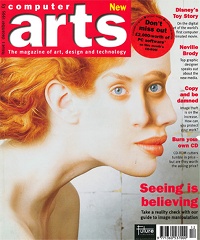Computer Arts 200: Neville Brody
Going back in time to 1995, we revisit a classic interview with one of the world's most influential designers.

In 1995, we launched issue one of Computer Arts magazine. As you can see from this selection of covers, back then it was a very different magazine to it is today. But one thing has been common over our lifetime – we've always brought you the best access to the most influential designers, image-makers, illustrators and creative professionals.
In our first issue, we sat down with Neville Brody – someone then we described as 'the most influential designer of the last ten years." We've interviewed Neville many times since, but as we approach issue 200 – on sale april 5th in the UK – we thought it would be great to look back on the designer's views back in 1995.
Interactive CD-ROMs were at the height of fashion, Research Studios had not long been going (after changing its name from The Neville Brody Studio) and the web was coming into its own. It was indeed a very different time…
Neville Brody: Q&A
The most influential designer of the last ten years, Neville Brody is one of the main driving forces behind contemporary typography. And now he’s embracing technology in a bear hug.
Interview: James Binns
I’ve just climbed a flight of stairs leading to the reception area of Islington-based Research Studios to meet the man dubbed as a god by almost every graphic designer I know. He should be dressed in an expensively cut matt black ‘suit’, maybe sipping a can of the latest fashionable lager and balancing on some un-sensible shoes. The man waiting to greet me, though, is wearing Vans sneakers, a pair of baggy cotton trousers and an unbranded navy T-shirt. Street smart but casual. Surely this can’t be the Neville Brody of the modern design world?
But it is. I know this because my photographer, who arrived earlier, is fussing ‘round him - though Brody won’t have any of it. “I’m starving,” he declares, so we leave the photographer setting up some lights and disappear to a Liverpool Road restaurant, which I’m assured is “cheap but good”. We open by talking about the renaming of his studio. Until recently it had been called The Neville Brody Studio, but it’s been renamed Research Studios. Why the change? “We don’t need the name to get work. And anyway it wasn’t fair to all the other talented people working here.” The starters arrive and Brody looks at my lifeless Sony dictaphone. “Shouldn’t you be recording this?” I reach for my questions, roll the tape and switch into interview mode.
Computer Arts: How does working with a computer influence the creative process?
Neville Brody: Is this going to be one of those sad nerdy conversations? Isn’t the point more about what the technology allows you to do rather than what you can do with the hardware? The whole thing has become so upside down. Design has become such a technology-obsessed industry.
CA: So are computers just tools or something more?
NB: I used to think computers were just tools. Because my initial response to the computer was that if a job can be done by hand, then you don’t need a machine to do it. Then I realised that it doesn’t affect the way you think about your work, just the way that you can do it. As a labour saving device it doesn’t save any time at all. It means you’ve got more time to try out more options, more time to do things you wouldn’t have been able to do before. So you don’t work any less. You work just as much, if not more. There’s more stuff happening all the time. And now we’ve got the bloody Internet to deal with.

CA: Have computers speeded up the creative process?
NB: It’s not even that. You should look at some old physical artwork. See how it used to be done. Before typesetting you’d have to do pencil roughs, enlarge things and trace them. Use photocopied photographs. It was a nightmare. You could never visualise it. Then you’d send off for your typesetting and you’d have to get it set in a few different sizes and typefaces because there was no opportunity to change it. Otherwise you’d get it back and think. “Oh, maybe it should be a bit bigger.” So you’d send it off again. It’d come back. Then maybe, “Oh this type face should be a bit heavier.” So of course you’d have to wait 24 hours or longer to get your typesetting done. Then they’d have to cut things up to make prints of it to different sizes and even then you couldn’t visualise it. It was all still in black and white. No colour. The thing with computers is that you can see what you’re doing.
CA: But have you lost the time to think and reflect?
NB: I would have said yes, but a lot of work that’s being produced now is still as thoughtful as it always was. I think there are a lot of people who don’t think, but that’s a different story.
CA: So how is a computer more than a tool?
NB: The mistake people have made is to assume that the computer is just a tool. It’s not just a labour saving device like a food mixer or washing machine. The computer is a new medium like television or cinema. Or books. You can use a book to make paper aeroplanes or something; that’s using it as a tool. But the best way to use a book is to read from it. People design on the computer for the physical world, but why not leave things on the computer? And then you start to realise your activity is changing. Because the way you behave and respond to a computer screen is completely different to television or cinema. So the whole premise of the activity is completely different. It’s like when television first appeared – they looked like radios because that’s what people were used to. And the way people performed on television, the way the sets were designed, it looked a lot like theatre. That’s what people were used to. So, it seems that all new technologies can only be accepted if they replicate an old technology. It’s going to be a while until people realise that computing is a new and different genre and that things can exist here which you wouldn’t see in any other medium.

Thank you for reading 5 articles this month* Join now for unlimited access
Enjoy your first month for just £1 / $1 / €1
*Read 5 free articles per month without a subscription

Join now for unlimited access
Try first month for just £1 / $1 / €1
Get the Creative Bloq Newsletter
Daily design news, reviews, how-tos and more, as picked by the editors.

The Creative Bloq team is made up of a group of art and design enthusiasts, and has changed and evolved since Creative Bloq began back in 2012. The current website team consists of eight full-time members of staff: Editor Georgia Coggan, Deputy Editor Rosie Hilder, Ecommerce Editor Beren Neale, Senior News Editor Daniel Piper, Editor, Digital Art and 3D Ian Dean, Tech Reviews Editor Erlingur Einarsson, Ecommerce Writer Beth Nicholls and Staff Writer Natalie Fear, as well as a roster of freelancers from around the world. The ImagineFX magazine team also pitch in, ensuring that content from leading digital art publication ImagineFX is represented on Creative Bloq.
